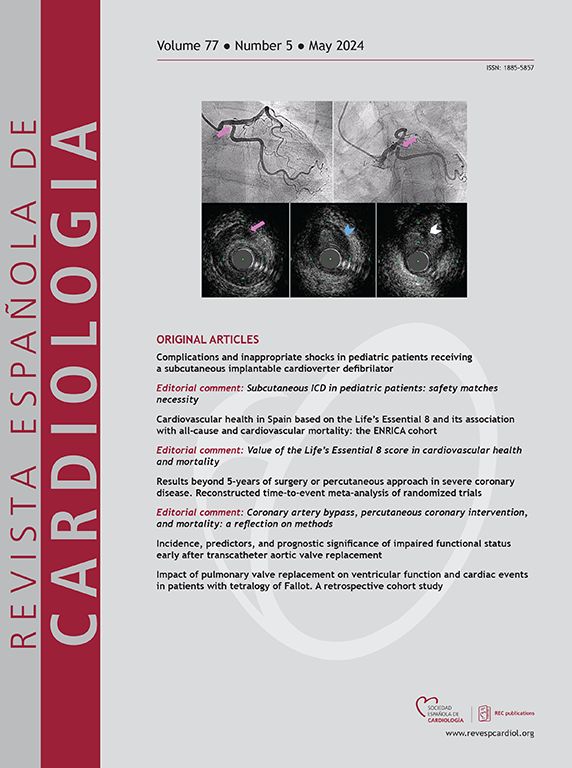Resultados de un servicio ininterrumpido de implante urgente de marcapasos permanente
IF 5.9
2区 医学
Q2 Medicine
引用次数: 0
Abstract
Introduction and objectives
Most of the complications associated with acute and symptomatic bradyarrhythmia (ASB) occur in the time from diagnosis to permanent pacemaker implantation (PPI). We aimed to evaluate the outcomes of an urgent 24/7 PPI service (PPI-24/7) for patients with ASB.
Methods
A total of 664 patients undergoing first-time PPI for ASB were prospectively assessed during 2 periods of identical length (18 months): 341 patients who underwent the procedure during working hours only (PPI-WH), and 323 patients who underwent the procedure after the implementation of the PPI-24/7 service. The primary safety endpoint was established as the cumulative 180-day incidence of complications related to the index arrhythmia and device implant. The primary efficacy endpoint was determined as the average number of hospital stays per patient.
Results
The PPI-24/7 period was associated with a significant shortening of the time from diagnosis to implantation (median [interquartile range]): 3 hours [2-6] vs 16 [5-21]). The cumulative incidence of patients with complications at 180 days was lower in the PPI-24/7 period: 9% vs 17% (adjusted odds ratio, 0.5; P = .002), due to a significant reduction in preimplant complications: 2.5% vs 12% (P < .001). The average number of hospital stays was reduced by 2 per patient in the PPI-24/7 period (nonparametric P < .001). PPI-24/7 implants performed outside working hours (n = 178) were safe, with a 180-day cumulative incidence in procedure-related complications of 3.9%.
Conclusions
Among patients with ASB, PPI-24/7 was associated with a significant reduction in patient morbidity and efficient hospital resource use.
全天候紧急永久起搏器植入服务的成果
导言和目的急性症状性心动过缓(ASB)的相关并发症大多发生在从诊断到永久起搏器植入(PPI)的过程中。我们的目的是评估为 ASB 患者提供的全天候紧急 PPI 服务(PPI-24/7)的效果。方法在两个相同时间段(18 个月)内对 664 名因 ASB 首次接受 PPI 的患者进行了前瞻性评估:在两个相同的时间段(18 个月)内,共对 664 名首次接受 PPI 治疗的 ASB 患者进行了前瞻性评估:341 名患者仅在工作时间接受治疗(PPI-WH),323 名患者在实施 PPI-24/7 服务后接受治疗。主要安全性终点确定为 180 天内与指数心律失常和设备植入相关的并发症累积发生率。PPI-24/7服务期显著缩短了从诊断到植入的时间(中位数[四分位间范围]:3小时[2-6小时]对16小时):3小时 [2-6] vs 16 [5-21])。在 PPI-24/7 期间,患者在 180 天内出现并发症的累计发生率较低:9% vs 17%(调整后的几率比,0.5;P = .002),这是因为植入前并发症显著减少:2.5%对12%(P = .001)。在 PPI-24/7 期间,每位患者的平均住院次数减少了 2 次(非参数 P < .001)。在工作时间以外进行的 PPI-24/7 植入手术(n = 178)是安全的,180 天内手术相关并发症的累积发生率为 3.9%。
本文章由计算机程序翻译,如有差异,请以英文原文为准。
求助全文
约1分钟内获得全文
求助全文
来源期刊

Revista espanola de cardiologia
医学-心血管系统
CiteScore
4.20
自引率
13.60%
发文量
257
审稿时长
28 days
期刊介绍:
Revista Española de Cardiología, Revista bilingüe científica internacional, dedicada a las enfermedades cardiovasculares, es la publicación oficial de la Sociedad Española de Cardiología.
 求助内容:
求助内容: 应助结果提醒方式:
应助结果提醒方式:


